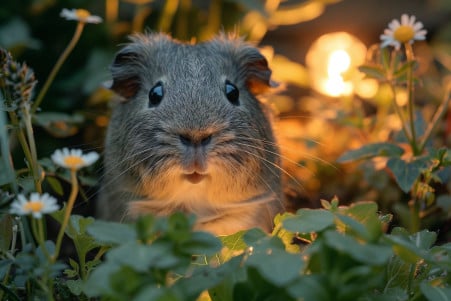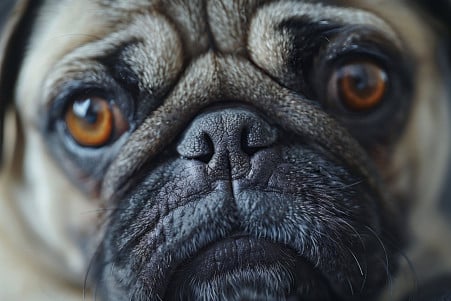Why Do Guinea Pigs Blink Less Than Humans? Exploring Guinea Pig Eyes
19 April 2024 • Updated 19 April 2024

If you’ve ever noticed that your guinea pig doesn’t blink nearly as much as you do, you’re not alone. Guinea pigs don’t have eyelids or tear ducts like humans, so they don’t need to blink as often to keep their eyes moist and free of debris. Instead, guinea pigs have a third eyelid, also known as the nictitating membrane, that moves horizontally across their eyes to protect and moisten them.
This article will explore the interesting ways that guinea pig and human eyes and vision differ. Through an exploration of research on guinea pig eyes and vision, you’ll learn about the unique ways that guinea pig eyes are structured and how they function, as well as how these differences have evolved to help guinea pigs survive in their natural habitats. This knowledge will help you better understand your pet and ensure that you’re meeting their needs to the best of your ability.
Do guinea pigs blink less than humans?
The Eye and Eyelid Movements of Guinea Pig Blinks
The eye and eyelid movements of guinea pig blinks are highly coordinated and involve a number of specific muscles. Electromyographic recordings have demonstrated that the orbicularis oculi muscle is responsible for the downward movement of the upper eyelid during a blink. Studies of eyelid movements have shown that guinea pigs have qualitatively similar eyelid movement patterns to humans and rabbits, although guinea pig blinks are much faster.
The blink is also associated with a number of eye movements. The eye retracts into the orbit, a translational movement that is driven by the retractor bulbi muscle. At the same time, the eye rotates upward and abducts as a result of the co-contraction of pairs of extraocular muscles. Quantitative analysis has shown that guinea pig blinks are much faster than those of rabbits and humans, with the downward phase of the blink lasting an average of just 41 milliseconds and reaching maximum velocities that are more than twice as fast as those of rabbits and humans.
While humans also show eye retraction during voluntary blinks, the rotation is more toward a "primary position" rather than a specific direction. This is in contrast to the more complex rotational paths taken by the eye during guinea pig blinks, which are likely a consequence of the eye retraction driven by the retractor bulbi muscle, which is much more developed in guinea pigs. These unique eye and eyelid movements demonstrate the evolutionary adaptations of guinea pigs' visual system, a theme we'll return to as we discuss the role of their specialized nictitating membrane.
The Nictitating Membrane: Guinea Pigs' Third Eyelid
Guinea pigs have a vestigial nictitating membrane, which is a transparent, thin third eyelid that moves horizontally across the eye. According to VIN, the nictitating membrane is located in the temporoventral region of the guinea pig's orbit. Unlike the upper and lower eyelids, the nictitating membrane moves across the eye to protect and lubricate it while still allowing the animal to see.
The nictitating membrane is present in many other species, including fish, amphibians, reptiles, birds, and some mammals. Wikipedia notes that it can be used to shield the eye during hunting, such as in sharks, or to protect the eye from UV light, such as in polar bears. In guinea pigs, the nictitating membrane likely helps protect the eye while allowing the animal to keep its eyes open while burrowing or foraging.
According to the Vetlexicon, guinea pigs have a very stable tear film, which is probably due to the increased lipid content from their Harderian gland. This, along with the nictitating membrane's regular movement across the eye, helps ensure the guinea pig can see and that its eyes stay healthy despite the fact that it blinks infrequently. Learning about the unique features of the guinea pig nictitating membrane helps researchers better understand the animal's vision and the biological processes that lead to its unusual blinking patterns.
Guinea Pig Blinking as a Form of Communication
Even though guinea pigs don't blink as often as humans, their blinking can still be a form of communication and expression. Hepper notes that the frequency of guinea pig blinks can be influenced by alertness, environmental factors, and health. For example, guinea pigs tend to blink less when they're comfortable and safe and more when they're in stressful or threatening situations.
A study of eye-blinking in 71 primate species published in PMC found that blinking can be a reliable indicator of an animal's emotional state and arousal level. Although there is little research on guinea pig blinking, it's possible that changes in the frequency or quality of their blinks could be a sign of stress, anxiety, or other emotions.
As a result, guinea pig owners can use their pet's blinking behavior to pick up on subtle signs about how they're feeling. Hepper's article suggests that if you notice any changes in your guinea pig's blinking, such as excessive blinking or signs of eye irritation, you should take them to the vet. Paying attention to these cues can help guinea pig owners ensure they're taking the best possible care of their pets.
Eye Health and Blinking in Older Guinea Pigs
In addition to the changes in blinking behavior, older guinea pigs may also experience changes in eye health and function. The Spruce Pets notes that cataracts (a condition in which the lens of the eye becomes cloudy) and blocked tear ducts (which can cause the eyes to water excessively) are two common eye issues that occur in aging guinea pigs and can directly affect a guinea pig's ability to blink.
In addition to these age-related concerns, Guinea Pigs Australia points out that eye infections, injuries, and allergies can also impact a guinea pig's ability to blink. Signs that may indicate an eye issue in a guinea pig include increased blinking, redness, abnormal discharge, and difficulty opening or closing the eyes.
PetMD warns that if left untreated, eye issues like conjunctivitis (also known as pink eye) can worsen and lead to more severe problems. Therefore, it's important to seek veterinary care as soon as possible if you suspect your guinea pig is experiencing an eye issue. In addition, make sure your guinea pig's living environment is clean and free from potential eye irritants to help reduce the risk of eye problems.
By knowing what to expect in terms of changes in blinking and eye health in aging guinea pigs and being able to recognize signs of potential issues, you can ensure that you're doing everything you can to keep your pet healthy. This understanding also sets the stage for a discussion of the evolutionary factors that have influenced the way guinea pigs see the world.
Conclusion: What Guinea Pigs' Eyes Can Tell Us
Guinea pigs' unique blinking patterns and eye movements are the result of evolutionary adaptations to their environment and behavior. The study on guinea pig visual function published in PMC found that guinea pigs have a directional selectivity in their visual tracking, with a greater sensitivity to stimuli moving temporally to nasally than nasally to temporally. This directional selectivity is likely an important part of their ability to detect and respond to threats or predators that may be coming from the sides.
The guinea pig's nictitating membrane, or "third eyelid", is an important adaptation that allows them to protect their eyes while still being able to see. As described on Wikipedia, the nictitating membrane is present in many prey animals and can protect the eye from things like dust and UV rays. In guinea pigs, this allows them to keep their eyes open while burrowing or foraging without risking injury.
Guinea pigs have some visual abilities that are unique even among other prey animals. The study on guinea pig visual function found that they have a well-developed photopic negative response in their electroretinogram, which is similar to humans and suggests advanced retinal processing. This is likely an adaptation to their crepuscular (dawn and dusk active) lifestyle and their burrowing behavior, both of which require them to have good visual sensitivity and contrast.
The evolutionary adaptations that have led to guinea pigs' blinking patterns and visual system are different from those of many other mammals and are a result of the specific challenges and requirements of their environment. Understanding these adaptations can help us understand more about the biology and needs of these interesting animals.


